 7Likes 7Likes
-
 2
Post By markharf
2
Post By markharf
-
 1
Post By markharf
1
Post By markharf
-
 1
Post By backofbeyond
1
Post By backofbeyond
-
 1
Post By shu...
1
Post By shu...
-
 1
Post By mark manley
1
Post By mark manley
-
 1
Post By JMo (& piglet)
1
Post By JMo (& piglet)
 |

11 Jul 2021
|
|
Registered Users
Veteran HUBBer
|
|
Join Date: Feb 2002
Location: Wessex, UK
Posts: 2,136
|
|
|
Detailed local paper maps of the USA
I am looking for a good local map similar to the Ordnance Survey Landranger or Explorer maps in the UK for San Luis Obispo county CA or general area, one that shows trails, footpaths and other rights of way, I am sure tourist maps are available but am looking for something with more detail, any suggestions?
|

11 Jul 2021
|
|
Super Moderator
Veteran HUBBer
|
|
Join Date: Jul 2007
Location: Bellingham, WA, USA
Posts: 4,031
|
|
|
Inquiries like this are more likely to draw useful responses if you say what sort of use you have in mind. Footpaths, for example, are really different from trails on which you can ride a bike, ride a motorcycle, or drive a four-wheeled vehicle. Also be aware that asking about local "rights of way" is likely to confuse, as will "green laning" "trekking," or other non-USA euphemisms; just ask about trails for walking/hiking if that's what you're after, or for off-road vehicle (ORV) use, or for mountain biking, or for whatever else as applicable. In the end you'll have to inquire locally anyway, noting that these are separate constituencies and often bitterly opposed to each other's interests.
I don't know anything about the British maps you reference, but as a fellow paper map user I have a few US suggestions which may meet your needs--or not. I find each of the following useful, but each also quite frustrating for their limitations.
The Atlas and Gazatteer series, now or formerly published by DeLorme.
The Road and Recreation Atlas series, n/f by Benchmark Maps.
The US Geological Survey (USGS) maps, in particular the 15 minute quadrangle series, [Beware: these are incredibly detailed but often painfully out of date].
The Trails Illustrated, now owned by the National Geographic.
The Green Trails series
Most people use online or similar maps these days. In my area, mountain bikers use the Trailforks app, but hikers might prefer Avenza, Maps.me, or Caltopo. In central California they may use apps I've never even heard of. I've found that paper resources are increasingly hard to find and dated, so I end up using apps to keep my paper maps updated.
Note that I know nothing whatsoever about the San Luis Obisbo area. Nonetheless, I hope that's helpful.
Mark
|

11 Jul 2021
|
|
Registered Users
Veteran HUBBer
|
|
Join Date: Feb 2002
Location: Wessex, UK
Posts: 2,136
|
|
Quote:
Originally Posted by markharf

Inquiries like this are more likely to draw useful responses if you say what sort of use you have in mind. Footpaths, for example, are really different from trails on which you can ride a bike, ride a motorcycle, or drive a four-wheeled vehicle. Also be aware that asking about local "rights of way" is likely to confuse, as will "green laning" "trekking," or other non-USA euphemisms; just ask about trails for walking/hiking if that's what you're after, or for off-road vehicle (ORV) use, or for mountain biking, or for whatever else as applicable. In the end you'll have to inquire locally anyway, noting that these are separate constituencies and often bitterly opposed to each other's interests.
I don't know anything about the British maps you reference, but as a fellow paper map user I have a few US suggestions which may meet your needs--or not. I find each of the following useful, but each also quite frustrating for their limitations.
The Atlas and Gazatteer series, now or formerly published by DeLorme.
The Road and Recreation Atlas series, n/f by Benchmark Maps.
The US Geological Survey (USGS) maps, in particular the 15 minute quadrangle series, [Beware: these are incredibly detailed but often painfully out of date].
The Trails Illustrated, now owned by the National Geographic.
The Green Trails series
Most people use online or similar maps these days. In my area, mountain bikers use the Trailforks app, but hikers might prefer Avenza, Maps.me, or Caltopo. In central California they may use apps I've never even heard of. I've found that paper resources are increasingly hard to find and dated, so I end up using apps to keep my paper maps updated.
Note that I know nothing whatsoever about the San Luis Obisbo area. Nonetheless, I hope that's helpful.
Mark
|
Thanks Mark,
The UK maps I mentioned are 1-25,000 and 1-50,000 and have all roads, footpaths, bridleways which you can cycle on and lots more so are very detailed and are kept fairly up to date, our public rights of way stay pretty unchanged from one decade or even century to the next, I presumed there was a US equivalent but perhaps not. I am looking for bicycle trails and have found several websites but I do not use GPS or mobile phone and like a paper map so will check out those you mention.
|

11 Jul 2021
|
|
Super Moderator
Veteran HUBBer
|
|
Join Date: Jul 2007
Location: Bellingham, WA, USA
Posts: 4,031
|
|
|
Sadly, no. The close equivalent--USGS 7.5 minute, 1:24,000 "quad" maps--are often horrifyingly out of date. For example, one I use fairly often shows a pack trail instead of the major highway which supplanted it in the 1960s--this despite claims it was updated several times since by aerial photos and field checks.
I blame the privatization belief system, in which private profit is claimed to motivate superior performance in all realms--an obvious delusion. As our government has abdicated, businesses have in some cases moved in, but this only applies if you want to go where everyone else goes (and will pay for commercially-produced maps). In some areas other governmental agencies and non-governmental groups have stepped up, so there are often Forest Service maps, or maps produced by local interest groups like off-road riders, mountain bikers, hikers, or even local Chambers of Commerce.
In this specific case, my 10 second search shows city, county, and commercial websites dedicated to San Luis Obisbo bike routes and trails. In the absence of smartphone, I'd download and probably print off a few, since many won't even exist in paper form. I also see that something called Traillink looks much more useful than my accustomed Trailforks. I'd caution against relying on guidebooks unless truly desperate, since in my experience they either don't exist at all, or are so hopelessly out of date that they work much better as doorstops or boat anchors [<--joke].
Bike paths and trails are rapidly changing in many areas of this country. You'll probably want to distinguish between more relaxed bike paths--flat-ish, wide, smooth, graded paths of gravel or asphalt--and mountain bike trails. That's because these are somewhat separate constituencies, though both tend to be rapidly expanding. Cities and tourist agencies tend to stay up to date on bike paths; mountain bike organizations and shops on their trails. If interested in the latter, I'd suggest phoning (i.e., on an actual telephone) a local shop or two to ask what's available in print and website versions; if more the former, chances are pretty good that city or county websites will have what you're after. In either case, even online resources tend to lag ongoing improvements (and printed maps much more so), so definitely ask around once on the ground.
Edit to add: It's worth knowing that bike shops are all completely overwhelmed these days, and therefore sometimes difficult to engage--even when proposing to pay hundreds of dollars for repairs or parts, or thousands for new bikes. Stay patient.
I'm going to step back now so as not to crowd out anyone who might chime in with actual local knowledge--I live a couple of thousand km away and am seldom back in that area.
|

12 Jul 2021
|
|
Registered Users
Veteran HUBBer
|
|
Join Date: Apr 2005
Location: Oxford UK
Posts: 2,116
|
|
|
I don't know California at all (only been there a couple of times) but over on the east coast which I know a little better I've never seen maps anything like UK OS or even the French IGN. The UK system of time immemorial foot/ horse paths that enable you to cross private land with the force of law behind you doesn't seem to exist in the US either. Leisure trails - yes, there's loads of those but the network is nothing like as extensive as we're used to here. When I've been looking for running routes over there Google maps has been as good as anything short of local knowledge.
|

12 Jul 2021
|
|
Registered Users
Veteran HUBBer
|
|
Join Date: Nov 2009
Location: Colorado
Posts: 313
|
|
For hiking I use-
https://caltopo.com/map.html#ll=38.8...6172&z=5&b=mbt
based on USGS 1/24,000 series topographic maps, with overlays from USForest, OSM, OpenCycleMap, and many more.
I can usually highlight my trail and print out my desired hiking area on a 8.5x11 sheet of paper at a reasonable scale. Of course you need access to a computer and a printer for this.
For backroads and 4 wheel drive tracks and trails, I like the state atlas by Delorme. My riding buddy doesn't like it and prefers the Benchmark series, which I find to be more difficult to read.
................shu
|

12 Jul 2021
|
|
Registered Users
Veteran HUBBer
|
|
Join Date: Feb 2002
Location: Wessex, UK
Posts: 2,136
|
|
Quote:
Originally Posted by shu...

For hiking I use-
https://caltopo.com/map.html#ll=38.8...6172&z=5&b=mbt
based on USGS 1/24,000 series topographic maps, with overlays from USForest, OSM, OpenCycleMap, and many more.
I can usually highlight my trail and print out my desired hiking area on a 8.5x11 sheet of paper at a reasonable scale. Of course you need access to a computer and a printer for this.
For backroads and 4 wheel drive tracks and trails, I like the state atlas by Delorme. My riding buddy doesn't like it and prefers the Benchmark series, which I find to be more difficult to read.
................shu |
That looks pretty useful, thank you.
|

12 Jul 2021
|
|
Registered Users
Veteran HUBBer
|
|
Join Date: Sep 2006
Location: California
Posts: 881
|
|
Hi Mark - as Markharf suggests, there are a number of resources, but nothing like as detailed as the British OS series unfortunately...
However, if it's recreation [paper]* maps you're after, then the National Geographic series of Trails Illustrated covers most of the popular recreation areas (and typically clearly defines hiking only vs. wheeled/motorised use too), and if you look on their website there is a map (#813) which covers the San Luis Obispo area:
https://www.natgeomaps.com/trail-map...aps/california
...which might be worth a punt? *note also that if you have the Gaia app, you can buy the National Geographic Trails Illustrated map layer for the whole of the US should you wish.
For general route planning, I'd also recommend the Benchmark Series of state-by-state Atlases... they don't cover the whole country, but they do cover pretty much everything out west, which is what most people want anyway ;o)
They have a huge amount of detail - which is also very accurate to what is on the ground I've found - including lots of tiny thread 'trails' which may or may not be suitable for vehicles - although pretty much any unpaved road/trail you'd ever want to ride a bike on is clearly marked. Perfect for overland route-planning!
Hope that helps...
Jenny x
|
|
Currently Active Users Viewing This Thread: 1 (0 Registered Users and/or Members and 1 guests)
|
|
|
 Posting Rules
Posting Rules
|
You may not post new threads
You may not post replies
You may not post attachments
You may not edit your posts
HTML code is Off
|
|
|
|

Check the RAW segments; Grant, your HU host is on every month!
Episodes below to listen to while you, err, pretend to do something or other...

2020 Edition of Chris Scott's Adventure Motorcycling Handbook.
"Ultimate global guide for red-blooded bikers planning overseas exploration. Covers choice & preparation of best bike, shipping overseas, baggage design, riding techniques, travel health, visas, documentation, safety and useful addresses." Recommended. (Grant)

Led by special operations veterans, Stanford Medicine affiliated physicians, paramedics and other travel experts, Ripcord is perfect for adventure seekers, climbers, skiers, sports enthusiasts, hunters, international travelers, humanitarian efforts, expeditions and more.
Ripcord Rescue Travel Insurance™ combines into a single integrated program the best evacuation and rescue with the premier travel insurance coverages designed for adventurers and travel is covered on motorcycles of all sizes.
(ONLY US RESIDENTS and currently has a limit of 60 days.)
Ripcord Evacuation Insurance is available for ALL nationalities.
What others say about HU...
"This site is the BIBLE for international bike travelers." Greg, Australia
"Thank you! The web site, The travels, The insight, The inspiration, Everything, just thanks." Colin, UK
"My friend and I are planning a trip from Singapore to England... We found (the HU) site invaluable as an aid to planning and have based a lot of our purchases (bikes, riding gear, etc.) on what we have learned from this site." Phil, Australia
"I for one always had an adventurous spirit, but you and Susan lit the fire for my trip and I'll be forever grateful for what you two do to inspire others to just do it." Brent, USA
"Your website is a mecca of valuable information and the (video) series is informative, entertaining, and inspiring!" Jennifer, Canada
"Your worldwide organisation and events are the Go To places to for all serious touring and aspiring touring bikers." Trevor, South Africa
"This is the answer to all my questions." Haydn, Australia
"Keep going the excellent work you are doing for Horizons Unlimited - I love it!" Thomas, Germany
Lots more comments here!

Every book a diary
Every chapter a day
Every day a journey
Refreshingly honest and compelling tales: the hights and lows of a life on the road. Solo, unsupported, budget journeys of discovery.
Authentic, engaging and evocative travel memoirs, overland, around the world and through life.
All 8 books available from the author or as eBooks and audio books
Back Road Map Books and Backroad GPS Maps for all of Canada - a must have!
New to Horizons Unlimited?
New to motorcycle travelling? New to the HU site? Confused? Too many options? It's really very simple - just 4 easy steps!
Horizons Unlimited was founded in 1997 by Grant and Susan Johnson following their journey around the world on a BMW R80G/S.
 Read more about Grant & Susan's story
Read more about Grant & Susan's story
Membership - help keep us going!
Horizons Unlimited is not a big multi-national company, just two people who love motorcycle travel and have grown what started as a hobby in 1997 into a full time job (usually 8-10 hours per day and 7 days a week) and a labour of love. To keep it going and a roof over our heads, we run events all over the world with the help of volunteers; we sell inspirational and informative DVDs; we have a few selected advertisers; and we make a small amount from memberships.
You don't have to be a Member to come to an HU meeting, access the website, or ask questions on the HUBB. What you get for your membership contribution is our sincere gratitude, good karma and knowing that you're helping to keep the motorcycle travel dream alive. Contributing Members and Gold Members do get additional features on the HUBB. Here's a list of all the Member benefits on the HUBB.
|
|
|
 7Likes
7Likes
 7Likes
7Likes